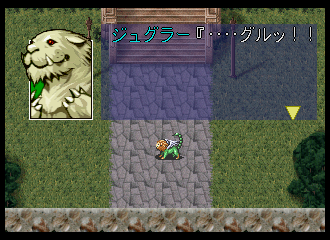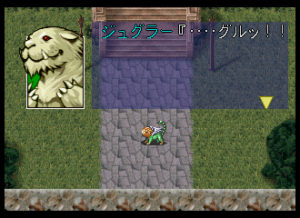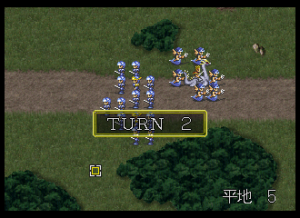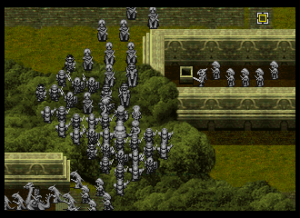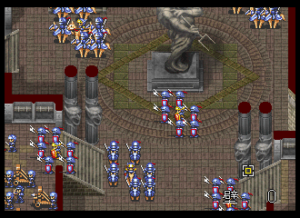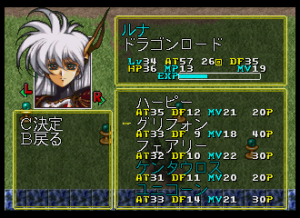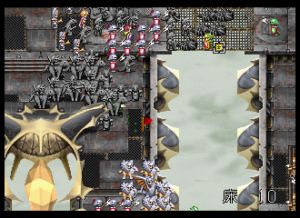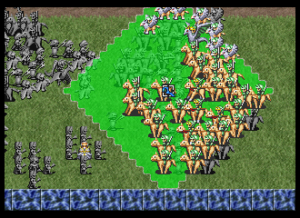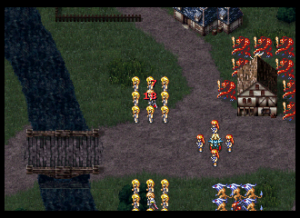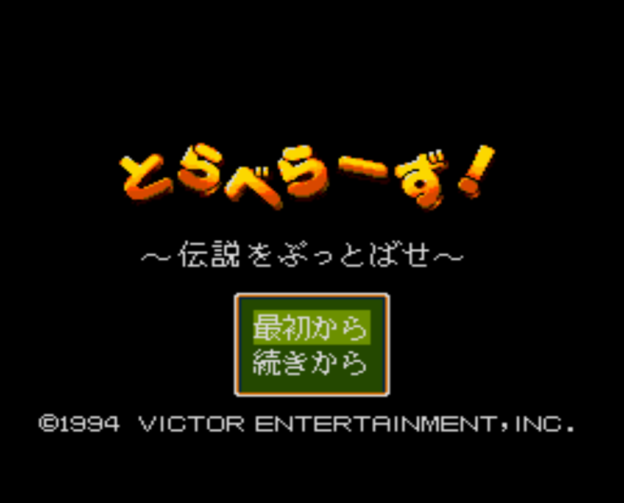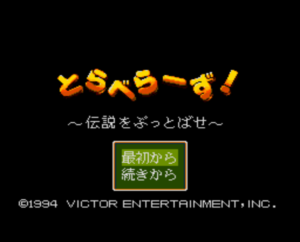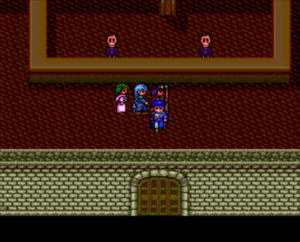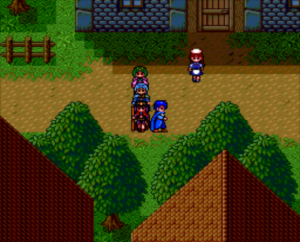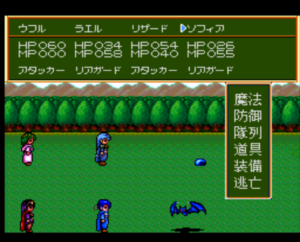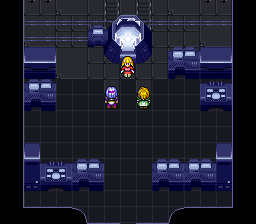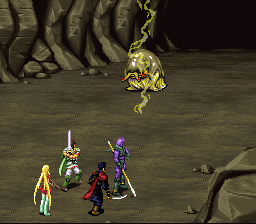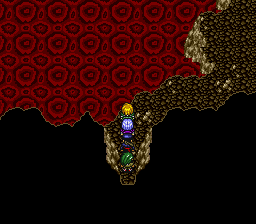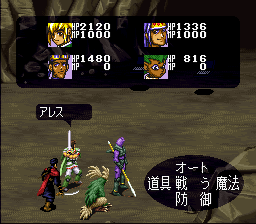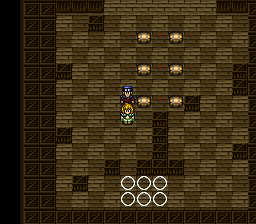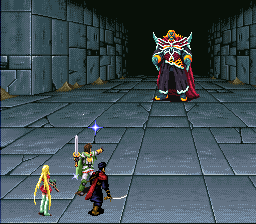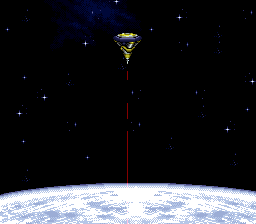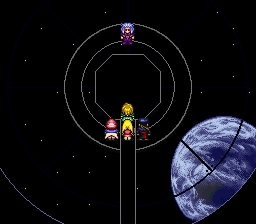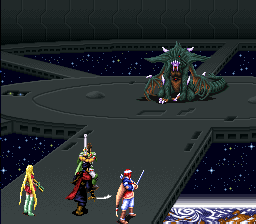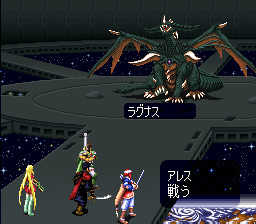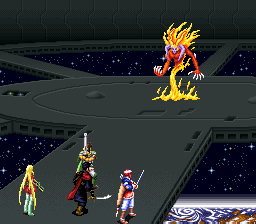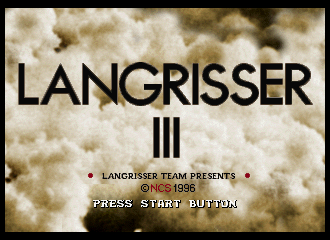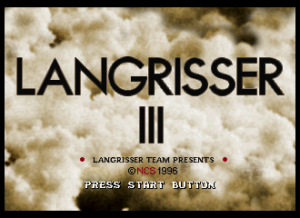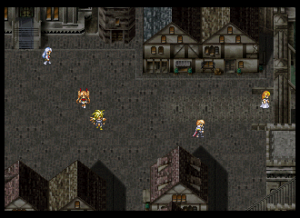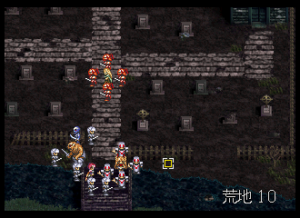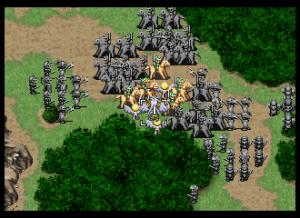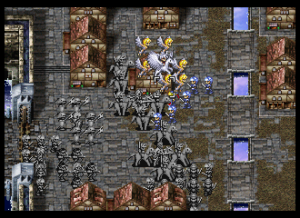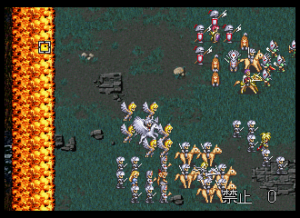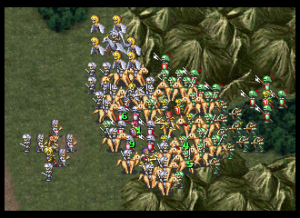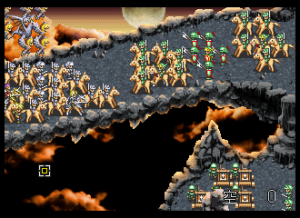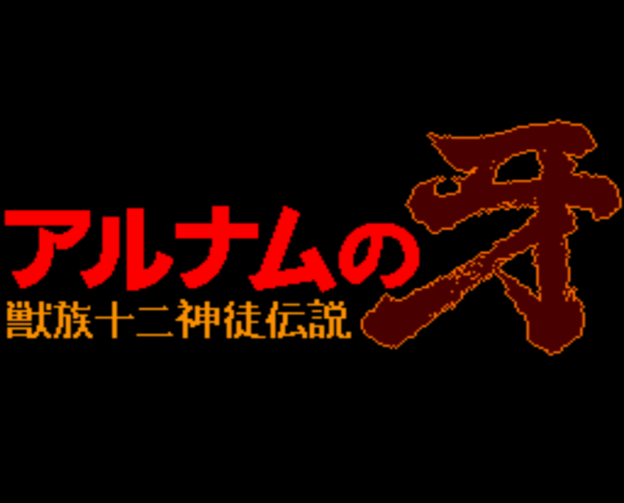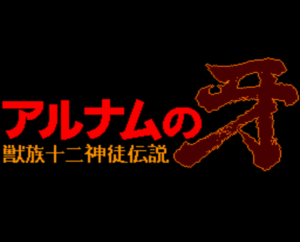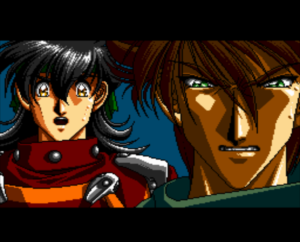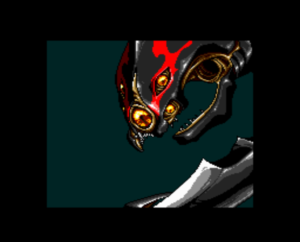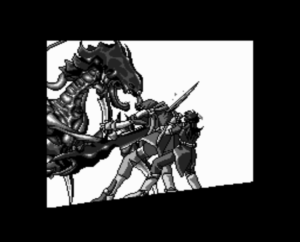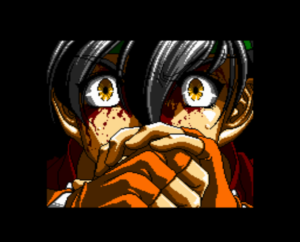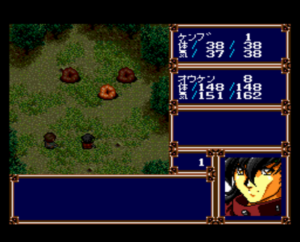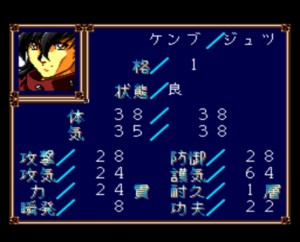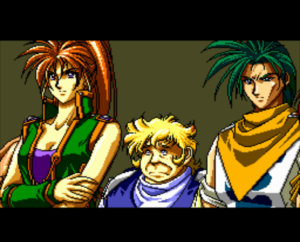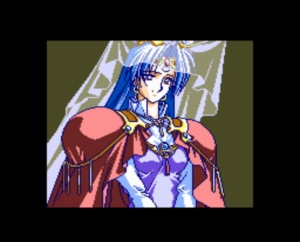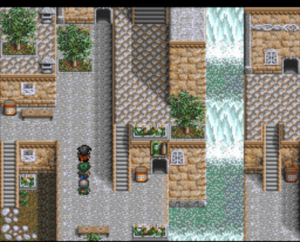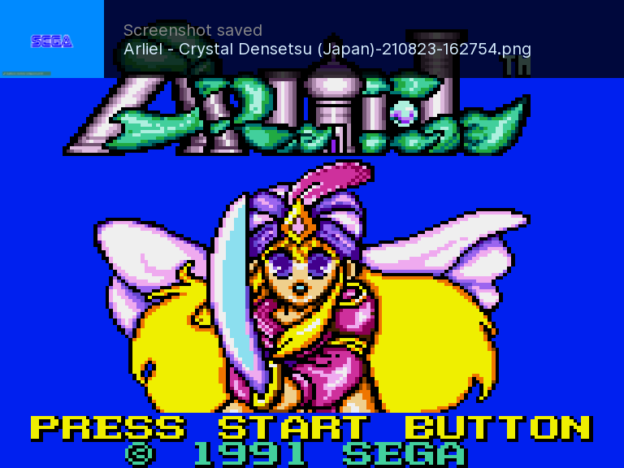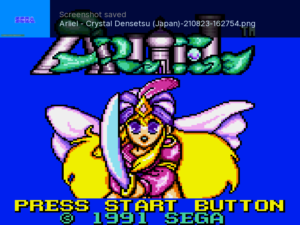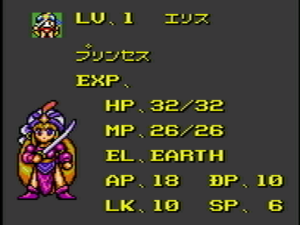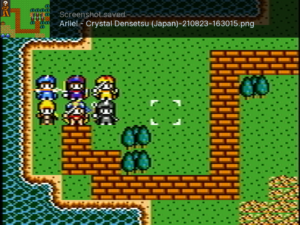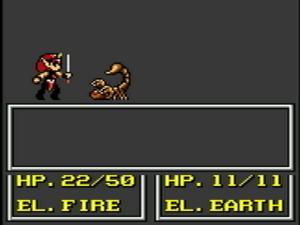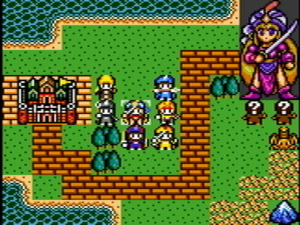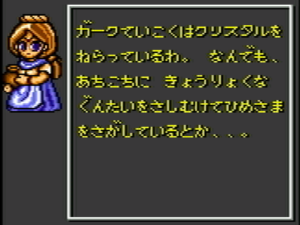Dual Orb 2 (デュアルオーブ2)
Released 12/29/1994, published by I’Max
Dual Orb 1 was complete garbage, one of the worst games I’ve played so far for this blog. I was not looking forward to the sequel. Fortunately it’s considerably better than the first one — it’s still average, perhaps below average, but at least it’s playable. The developer I’MAX mostly did Mahjong, Shogi, and other gambling games; the Dual Orb games seem to be their only foray into RPGs. The game has a translation patch so you can give it a try.
The system is pretty basic DQ2 style. The main distinctive feature is the weapons; rather than buying new weapons you mostly upgrade them in towns. Each character has only 1-3 weapons they can ever get in the game; beyond that you have to find +X versions or upgrade them at a blacksmith. +20 is the maximum and if you get it that far you get a special move you can do with the weapon when you’re in critical health. The cost goes up drastically as the +X gets higher but the better the blacksmith is, the cheaper it is to upgrade. You can also find already upgraded versions in dungeons but they might also be cursed -1 weapons (you don’t know until you equip it).
This is an interesting system but I don’t think it’s implemented particularly well. You will not get any weapons to +20 (or even close) without doing a lot of end-game grinding for money.
The random encounter rate is high; not as high as Last Battle or some of the other games like that, but high enough to be annoying. The balance on the whole is not good. Enemies do a lot of damage, even grunt units. Bosses frequently require a lot of grinding to beat just because they hit so hard it’s impossible to survive — particularly when they have hit-all spells (there’s no heal-all spell), and they can often take multiple turns for your one.
Here’s the intro from Arcadia’s Gamefaqs walkthrough:
A dragon appears in the night sky, intent on destroying all it
sees. Elsewhere, a man and a woman, Alex and Sera try desperately
to stop it. With no other option left, they decide to use their
final plan, the Orb. Alex activates the Orb, sacrificing himself
in the process, but also destroying the dragon.
Many years later, a man, walks through the snow, carrying a baby
he found. The man is a priest of Kaleid, on his way back from a
training journey, in order to be promoted to High Priest. He shows
the baby to the King. While he was walking in the Coriander
mountains,a group of white-clad people suddenly appeared, gave the
baby to him, along with a strange crucifix, then disappeared. The
king looks at the crucifix and wonders of the strange people were
sent from God. The High Priest has decided to keep him, and names
him Ales. The King brings his son, Ragnas, and shows him the baby,
insisting that they grow up to be friends. He sends the soldier to
spread the news of the High Priest's promotion and prepare to
celebrate.
...
Several years later, and old man [Hardwick] awakens on a table, surrounded by
a scientist and three others. The leader, Oldras, rejoices, having
succeeded in his plans. This man is the key to their finally
gaining the power of the ancient relics...
You begin with Ales, who is training with the king’s son Ragnas. After a brief sparring match they head home but are ambushed by thieves — fortunately a bard Cornelius comes in to save them.
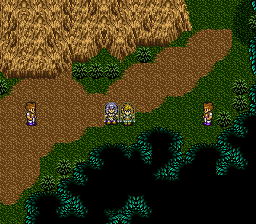
After returning, it turns out Cornelius is from Highlandia, which is being attacked by a foreign nation that is unearthing ancient technology. He wants to find the ancient ruins before they can do so. The King decides that Ales and Ragnas should go with him. Ales has healing spells but also attacks decently, and Ragnas is just a fighter.
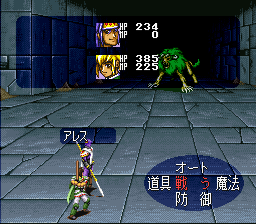
It takes a while to get any good weapons — you start off with wooden sticks that don’t do much. Until I found the spear in the first dungeon I basically had to run from everything. One general annoyance about this game is that they often like leaving you in situations where you can’t buy anything or use an Inn.
We find a green jewel and the girl Sara from the opening, although she doesn’t remember anything but her name. The priests in town thinks she’s a goddess because the jewel is glowing, and it only does that in the presence of the goddess. We also learn that the Red, Blue, and Green jewels are around the world and can unite to form the Orb. Sara joins the party; she’s also a healer and attacks with guns — her weapons cannot be upgraded, but you find new ones in ruins. She tends to be a pretty good attacker if she can survive.
Meanwhile Hardwick has attacked Kaleid. We try to save the King but he gets killed; all we can do is escape and head back to the ruins where there’s a suit of armor that hears Ragnas’ cry for help, and bonds with him. Now he can cast magic, which his helpful (he has a def buff and some elemental spells). Hardwick tries to stop us but Cornelius holds them off while we escape.
Our next goal is the nearby kingdom of Corodos, which is allied with Kaleid and should help us. But we need the help of our next player character Saladin to get through a forest. Saladin is also a combo fighter-mage.
Unfortunately Corodos refuses to help because they’re too busy fighting off goblins from the SW ruins, which is odd since goblins usually don’t want anything but food. There’s also a mysterious masked figure, and once we find out that the “goblins” are actually the Gurica tribe of demihumans, it’s obvious the masked man is controlling Corodos. One of the Gurica (Najif) joins temporarily in place of Sara.
We get back to Corodos but the king already knows about the Gurica, and he’s the one who sent the army against Kaleid. We beat him up, and then destroy the staff that the masked figure was using to control everyone. Now that all that has been dealt with it’s time to go to the ruins.
This ruin is like the other one, with advanced technology, a boss guardian, and this time the Red jewel, which joins with the green. Back at the Gurica village Sara has recovered but the masked figure is back. He tries to kill us but Saladin is able to fight him off with a spell (he seems to have a hidden identity). Although Saladin stops the dude from killing us, he kidnaps Sara.
We’re not sure where Sara is, but time to cross the sea — this is the usual “get a ship” part of the RPG. Cornelius returns; turns out he’s a spy and can show us the way to the hidden spy city (which moves). Unfortunately Hardwick is already there and tries to kill us, but Ragnas agrees to go with him (he wants Ragnas’ armor). Hardwick decides to kill us anyway, but the power of the jewels teleports us away to a mysterious mountain.
We go down the mountain and head for a port to take a ship. We run into another future party member Carline, who is trying to rescue her brother from pirates. Since Cardosa is blocking the sea we can’t really get across anyway so we decide to help her find her brother. This involves hunting down the pirates and beating them up, although we get involved in a fight between rival pirates in the process.
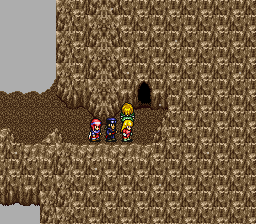
There’s a part where you have to do a puzzle to push casks into specific areas; it’s actually a somewhat challenging puzzle and is not optional.
Eventually we recover Elliot and reach the friendly pirates’ location, Gadmos, which is actually a giant turtle. It also turns out that Elliot and Carline are the children of the King of Highlandia, so that’s a nice ally to get. We also learn in Highlandia some of the past lore — if the three jewels come together they can make an Orb. This Orb can help us defeat the ancient weapon that Hardwick is trying to unearth, which seems to be a flying fortress.
We head out to Gassa to try to form an alliance, and there find the third jewel. This is the toughest dungeon so far, with a guardian that does an enormous amount of damage. There are shops in Gassa but they’re hard to find and I didn’t know they existed until after I finished the dungeon. Fortunately there is a heal spring in the dungeon, so I just used that to grind about 10 levels until I had Full Heal on Ales.
Afterwards we get the third jewel and also learn more about the past; Sara and Alex (in the opening) were fighting against Chandra, who is Alex’s friend. Alex sends Sara to the future to help future generations deal with Chandra while he stops him (temporarily) with the orb. There’s also a lot of side stories here (I’m just touching the broad elements of the story; it’s more complex than this). The mages of Gassa then send us back to Kaleid, where we started.
The high priest in Kaleid gives Ales a cross and sends us to Coriander mountain to learn the truth about Ales. There, we find another advanced technology tower and a hologram from Alex. Alex tells us about Chandra, who misused the technology to almost destroy the world, and it was only the Orb that saved the world. Now Ales (a clone of Alex) and Sara have to use the Orb again to defeat Chandra.
We now get a flying Ornithopter (buried by Alex) and can go anywhere in the (small) world. There’s a town Cronheit that has the cheapest blacksmith in the game, although it still costs a huge amount of money to upgrade any weapons to max. But the next destination is Hardos, which Hardwick has attacked. Unfortunately Carlina has been captured so it’s time to save her, vs another tough boss fight.
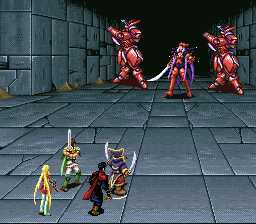
This is another time when you get stuck with no shops, and have to do a lot of grinding. The enemies just hit too hard and too fast to do otherwise — there’s a spell that paralyzes enemies that works on the robot grunts but even with that you can get hit really hard. Buffs stack, so often if you just keep casting the def+ and mag+ over and over again you can get to the point where your defense is finally high enough to withstand some attacks, and Saladin can do 9999 with his spells. At this point if you also have Full Recovery and Full Heal, it’s possible to beat the enemies. Around level 50 is enough to win the rest of the fights in the game through this method, if you also grind money to level up your weapons. I will admit that I got frustrated enough that I used a money code to upgrade my weapons because I had done so much grinding in the game already and I was not looking forward to the prospect of even more grinding (I didn’t do this until the final dungeon, though).
Anyway, next up is the flying fortress that destroyed Hardos. There’s another tough enemy here, but the aforementioned strategy works.
Ragnas is with Hardwick at the top — he seems to have been corrupted to evil now. The Armor that he found early in the game is actually a vessel for Chandra to return. There’s yet another difficult combat against Oldras, one of Hardwick’s generals, which you have to fight with only 3 guys.
If you want to earn money legitimately, go to Cardosa to fight gold beetles for cash — it’s time for the final dungeon.
The final fight is Ragnas; first you have to fight him in several forms (the buff strategy works fine on this and the final boss).
Then Chandra (with the regular battle music!)
And that’s the game.
—
The story is the best part of the game; I just sketched the outline above but there are a lot of sideplots and background for the various characters. It doesn’t seem to have any connection to Dual Orb 1 and I’m not even sure why this is “dual” orb since there’s only one orb in this game. There is a translation patch as well.
The gameplay could be a lot better, though. The game balance forces a lot of grinding, which I never like, and as I said above I think the weapon upgrade system is flawed. I barely got to use the special attacks except at the very end of the game, and even then you can only use them when you’re in critical HP and it’s very easy to get killed by the enemies. There is a good XP code that just gives you max XP after a battle (raising you 2-3 levels); this allows you to skip some of the grinding without having totally overpowered characters.
So this is light years better than Dual Orb 1, but it’s still a flawed game in many ways.
Next up is a PCE game and then we’re done with 1994!
